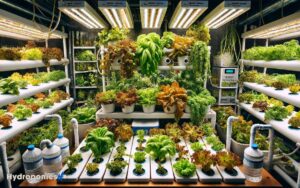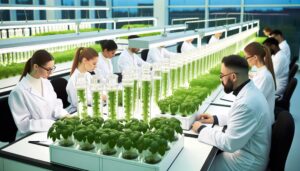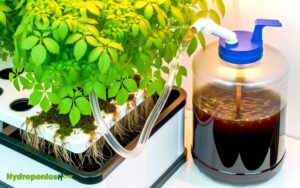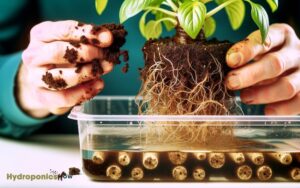Explaining How Long Hydroponic Plants Can Go Without Water
Hydroponic plants can survive without water for a few hours to a couple of days. The exact duration depends on factors like the type of hydroponic system, plant species, temperature, and humidity.
Deep Water Culture systems provide constant hydration, while Ebb and Flow systems require careful timing.
Leafy greens need consistent water, whereas root vegetables need precise management. High temperatures and low humidity increase water evaporation, stressing plants.
Automated systems can prolong periods between manual interventions. For understanding how to optimize water retention and guarantee plant health, there’s more you should consider.
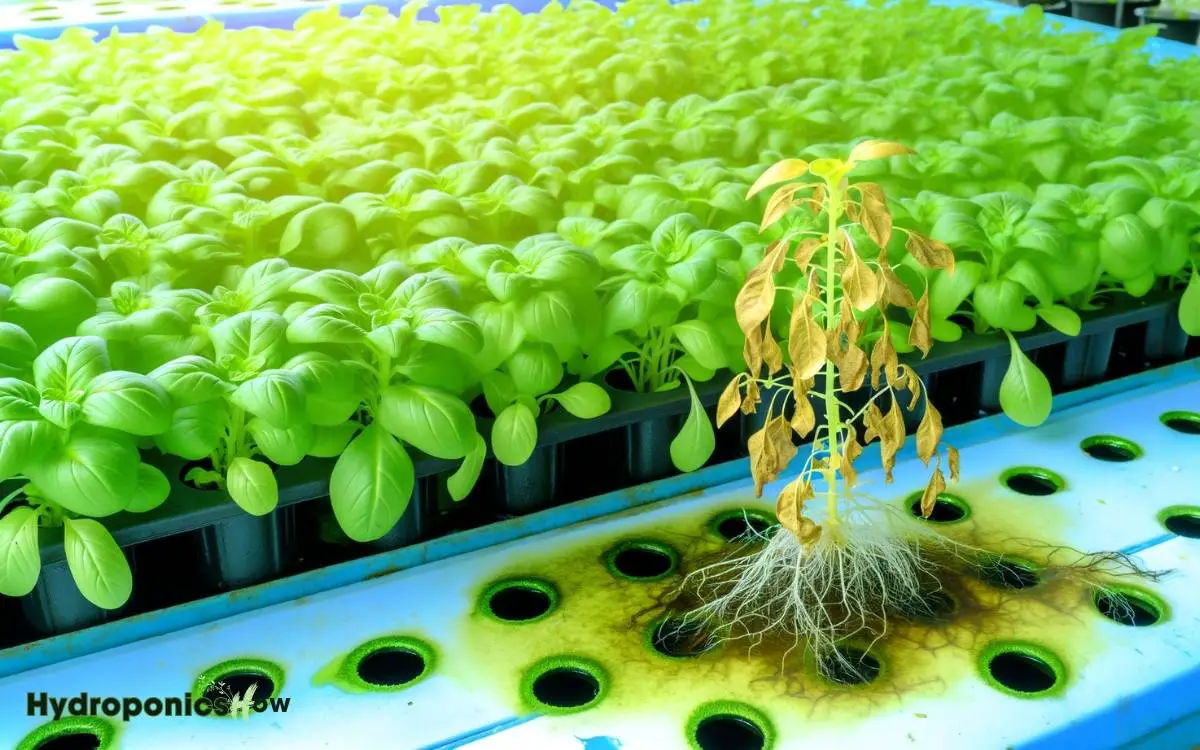
Key Takeaways
Importance of Water in Hydroponics
Ensuring an essential water supply is crucial for the success of hydroponic systems. Water serves as the primary medium for nutrient delivery to plants in hydroponics.
It is not just a source of hydration; rather, it is how plants receive the essential minerals and nutrients necessary for their growth.
By dissolving nutrients in water, a solution is created that roots can easily absorb. This method bypasses soil, significantly reducing the risk of diseases and pests. Proper water management is key to ensuring that plants receive a continuous and balanced nutrient supply.
Monitoring water quality, pH levels, and temperature consistently is necessary. Any imbalance in these factors can disrupt nutrient uptake and harm plant health. Therefore, understanding the critical role of water is essential for optimizing the performance of your hydroponic system.
Factors Affecting Water Retention
Several factors influence water retention in hydroponic systems, impacting how efficiently plants can absorb nutrients.
- First, the type of growing medium you use plays a significant role. For instance, coco coir retains water well, while perlite drains quickly.
- Second, the temperature and humidity levels in your growing environment affect evaporation rates warmer, drier conditions cause faster water loss.
- Third, the plant’s growth stage determines its water uptake; seedlings need less water compared to mature plants.
- Lastly, your system’s design, including reservoir size and flow rate, directly affects how long water is available.
Understanding these variables helps you optimize your hydroponic setup, ensuring plants get consistent hydration for best growth.
Types of Hydroponic Systems
Understanding the factors that affect water retention is essential when choosing the right hydroponic system for your plants.
Different systems offer varied benefits and challenges:
- Deep Water Culture (DWC): Plants are suspended in nutrient-rich water, providing constant hydration.
- Nutrient Film Technique (NFT): A thin film of nutrient solution flows over the roots, requiring precise monitoring.
- Ebb and Flow (Flood and Drain): Periodically floods the grow tray, then drains, offering intermittent hydration.
- Drip System: Delivers nutrients directly to the plant roots through a drip emitter, allowing for controlled feeding.
- Aeroponics: Roots are suspended in air and misted with nutrient solution, providing high oxygen levels.
Each system’s design impacts water availability and retention, essential for maintaining plant health and growth. Choose wisely based on your specific needs.
Plant Species and Water Needs
Different plant species have unique water needs that directly influence the effectiveness of your hydroponic system. For instance, leafy greens like lettuce require consistent water availability, while herbs like basil can tolerate short dry periods.
Tomatoes and cucumbers, which are fruit-bearing, need a steady water supply to prevent stress and guarantee maximum yield. Root vegetables like radishes demand precise water management to avoid root rot.
To guarantee your plants thrive, you must tailor your watering schedule to their specific needs. Monitor water uptake and adjust the nutrient solution flow accordingly.
By understanding each species’ requirements, you’ll maximize growth and productivity in your hydroponic setup. By monitoring factors such as nutrient levels, light exposure, and water quality, you can create optimal conditions for each plant. Understanding how long hydroponic plants take to grow will also help you plan your harvest cycles efficiently. With careful planning and proper maintenance, your system can produce healthy, high-yield crops year-round.
Temperature and Humidity Effects
You need to monitor temperature and humidity closely to maintain ideal growth conditions for your hydroponic plants. High temperatures can accelerate water evaporation and nutrient uptake, risking plant stress.
Controlling humidity is essential to prevent mold growth and maintain consistent transpiration rates.
Optimal Growth Conditions
Maintaining the appropriate temperature and humidity is essential for hydroponic plants to thrive and reach their peak growth potential. You need to monitor these conditions meticulously.
Ideal temperatures generally range between 65°F and 75°F, while humidity levels should stay between 50% and 70%. Deviations can hinder nutrient uptake and slow plant growth.
Key considerations include:
- Temperature Range: Make sure your system operates within the 65°F-75°F window.
- Humidity Levels: Maintain 50%-70% humidity to prevent fungal growth.
- Air Circulation: Utilize fans to keep air moving and avoid stagnant conditions.
- Monitoring Tools: Invest in reliable hygrometers and thermometers.
- Adjustments: Be prepared to use humidifiers, dehumidifiers, or heaters as needed.
High Temperature Risks
When temperatures exceed the ideal range of 65°F-75°F, hydroponic plants can suffer from impaired nutrient absorption and increased susceptibility to diseases.
Elevated temperatures cause the plant’s metabolic rate to spike, which can lead to rapid water evaporation from the nutrient solution. This not only stresses the plants but also concentrates the remaining nutrients, potentially leading to toxicity.
The root zone’s oxygen levels decrease in warmer conditions, further impairing root function. You must monitor your system’s temperature closely, using cooling mechanisms like fans or chillers if necessary.
Addressing high temperatures promptly ensures your plants maintain peak health and productivity.
Humidity Control Importance
Beyond temperature, maintaining ideal humidity levels in your hydroponic system is equally vital for guaranteeing robust plant growth and preventing disease.
Humidity affects transpiration rates and nutrient uptake, directly impacting plant health. Ideal humidity levels help prevent mold and mildew, which can devastate your crops.
Key considerations for humidity control include:
- Humidity Sensors: Use reliable sensors to monitor and adjust humidity levels accurately.
- Ventilation: Ensure proper airflow to avoid stagnant air, which can lead to fungal growth.
- Dehumidifiers: Employ dehumidifiers if the environment becomes too moist.
- Mist Systems: Use misting systems to increase humidity during dry spells.
- Plant Spacing: Adequate spacing allows for better air circulation, reducing the risk of disease.
Accurate humidity control ensures your hydroponic plants thrive.
Signs of Water Stress
You need to monitor hydroponic plants for signs of water stress such as wilting and drooping, which indicate insufficient water uptake.
Look for leaf discoloration, as yellowing can signal nutrient deficiencies linked to improper watering.
Stunted growth is another critical indicator, suggesting chronic water stress affecting overall plant health.
Wilting and Drooping
Wilting and drooping in hydroponic plants signal acute water stress and demand immediate attention to prevent irreversible damage.
These symptoms indicate that your plants aren’t receiving the necessary moisture and oxygen balance. To address this issue, you need to act swiftly and adjust your system.
Key indicators of water stress include:
- Wilting leaves: Leaves lose their turgor pressure and become limp.
- Drooping stems: Stems start to bend and lose their rigidity.
- Reduced growth: The plant’s overall growth slows down or stops.
- Curling leaves: Leaves may curl inwards as they dehydrate.
- Dull appearance: Leaves lose their vibrant color and appear dull.
Leaf Discoloration
Leaf discoloration, often manifesting as yellowing or browning, is a critical indicator of water stress in hydroponic plants. When your plants don’t get enough water, they can’t transport essential nutrients effectively.
This nutrient deficiency results in chlorosis, where leaves lose their green pigment. In hydroponics, this can happen rapidly due to the absence of soil, which normally acts as a buffer.
You might notice the edges of the leaves turning brown and crispy, a sign of severe water stress. The discoloration typically starts from the older leaves at the base and moves upward.
Regularly check for these symptoms to ensure timely intervention. Proper water management is crucial to prevent irreversible damage and maintain plant health.
Stunted Growth
In addition to leaf discoloration, water stress in hydroponic plants often manifests as stunted growth, hindering their overall development and productivity. You’ll notice that your plants don’t reach their full size potential and their growth rate slows considerably.
These symptoms are clear indicators of insufficient water supply, which is critical for nutrient uptake and cellular function.
Key signs of stunted growth due to water stress include:
- Reduced leaf size: Leaves appear smaller than usual.
- Shorter internodes: The spacing between leaves is shorter.
- Delayed flowering: Plants take longer to bloom.
- Weak root system: Roots appear underdeveloped and fragile.
- Overall plant wilting: The plant exhibits a droopy appearance.
Understanding these signs helps you take corrective measures promptly, ensuring your hydroponic system operates efficiently.
Emergency Watering Solutions
If your hydroponic system fails and plants are at risk, consider using manual watering techniques to sustain them temporarily.
First, prepare a nutrient solution identical to what your system uses. Using a clean, handheld sprayer or watering can, gently mist the roots until they’re fully saturated.
Guarantee the water drains well to prevent root rot. You can also place plants in a temporary container with a small amount of nutrient solution, allowing the roots to absorb it through capillary action.
This method ensures consistent moisture. Monitor the plants closely for signs of stress or dehydration.
Manual watering isn’t a long-term solution but can effectively bridge the gap until your hydroponic system is operational again.
Automation and Backup Systems
To guarantee consistent watering, you should use timers that automate the process, maintaining precise intervals.
Additionally, integrating an emergency water supply system can safeguard against pump failures or power outages.
Combining these elements will enhance reliability and minimize risks in your hydroponic setup.
Timers for Consistent Watering
Timers guarantee your hydroponic plants receive precise watering intervals, essential for maintaining ideal growth conditions. You can customize these devices to meet specific plant needs, enhancing both efficiency and productivity.
Key advantages include:
- Precision: Ensures exact watering times, reducing over- or under-watering.
- Consistency: Maintains a steady routine, vital for peak plant health.
- Flexibility: Offers programmable settings for various growth stages.
- Convenience: Allows you to manage your system remotely, saving time.
- Reliability: Minimizes human error, increasing overall system dependability.
Emergency Water Supply
Guaranteeing your hydroponic system has an emergency water supply is crucial for safeguarding against unexpected disruptions and maintaining plant health.
Install an automated backup system that activates when primary water sources fail. You can use float switches connected to secondary reservoirs, ensuring uninterrupted water flow.
Additionally, integrating sensors to monitor water levels and detect leaks can help preemptively address potential issues.
Battery-operated pumps serve as a reliable alternative during power outages, keeping your plants hydrated. Regularly test and maintain your emergency systems to ensure they’re functional.
Short-Term Absences
Even if you’re away for a few days, hydroponic systems can maintain plant health with minimal adjustments.
To guarantee your plants thrive during short-term absences, utilize these strategies:
- Automated Timers: Set up timers to regulate the water and nutrient delivery.
- Reservoir Size: Use a larger reservoir to extend the water supply duration.
- Check Valves: Install check valves to prevent backflow, ensuring consistent nutrient delivery.
- Air Stones: Add air stones for continuous oxygenation, reducing the risk of root rot.
- Nutrient Solution: Confirm the nutrient solution is well-balanced and sufficient before leaving.
Long-Term Water Strategies
For extended periods away from your hydroponic system, implementing robust long-term water strategies guarantees sustained plant health and growth.
Start by investing in a reliable automated irrigation system. Configure it to deliver consistent water flow tailored to your plant’s needs.
Incorporate a large reservoir to guarantee an ample supply of nutrient solution. Use water level sensors to monitor and maintain ideal levels, preventing any risk of drying out. Additionally, integrate a backup power source to keep the system running smoothly during outages.
Regularly check and clean all components to avoid blockages and malfunctions. By taking these measures, you’ll create a resilient hydroponic setup that’s capable of thriving even when you’re not physically present.
Preventing Water Loss
Minimize water loss in your hydroponic system by utilizing closed-loop systems and implementing proper sealing techniques.
A closed-loop system recirculates water, reducing evaporation and waste. Proper sealing prevents leaks and guarantees that all water is directed to your plants.
Consider these strategies to optimize water retention:
- Insulate reservoirs to maintain consistent water temperature and reduce evaporation.
- Use float valves to automatically refill water levels, maintaining ideal conditions.
- Install humidity domes to create a microenvironment that retains moisture around plants.
- Apply anti-evaporation covers on open water surfaces to minimize loss.
- Regularly check and repair any leaks or weak points in the system.
These methods ensure efficient water use, helping your hydroponic plants thrive with minimal water loss.
Conclusion
In hydroponics, water is vital. Your success hinges on understanding water retention, selecting the right system, and knowing your plants’ needs.
Temperature and humidity play roles, but automation and backups guarantee stability. Short-term absences require planning; long-term strategies prevent disaster.
By preventing water loss, ensuring constant monitoring, and adapting to conditions, you’ll maintain healthy, thriving plants.
Remember, water management isn’t optional—it’s essential. Your vigilance, your preparation, your system’s efficiency will determine your hydroponic garden’s success.

